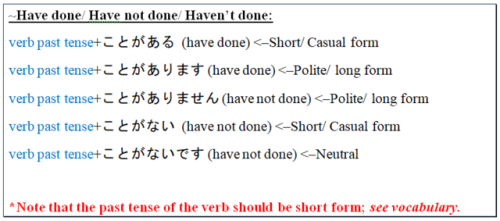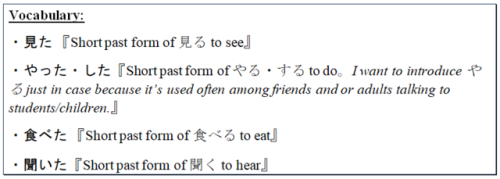Additional Vocabulary Used:・日本 『にほん』ー Japan・中国 『ちゅうごく』ー China・歌 『うた』ー Song・イスラエル ー Israel・ボードゲーム ー B
Additional Vocabulary Used:・日本 『にほん』ー Japan・中国 『ちゅうごく』ー China・歌 『うた』ー Song・イスラエル ー Israel・ボードゲーム ー Board game・ミュージック ー MusicHiragana I forgot to include, sorry:・見る 『みる』ー・食べる 『たべる』ー・聞く 『きく』ーMy personal feeling on this Japanese sentence structure is that you should learn and use it as early as possible if you want to have more natural conversations. Despite it being N3 for Japanese learners, it is very basic grammar in general. My host brother who was 7 years old at the time used it so much.What it can look like in conversation:My host sister was really excited to take me to Daiso. It’s one of her favorite stores and I had only been in Japan for a month (she most likely assumed I had never been to one because she thought that they only existed in Japan) and it would be my first time going IN JAPAN. So she asks me:妹:エンジェルちゃん、DAISOに行ったことがありますか?私:うん、行ったことがあります。妹:えー!?行ったことがあるよ?私:うん、カリフォルニアに行く時、DAISOに行きました。だから、DAISOにもう行ったことがあります。When I lived in Japan I used it often enough to remember and learn it without study aids. There are more in depth ways of using this grammar, of course. Such as if you were not to use a past form it would change the meaning:ピーナッツを食べないことがありますか? Are there times that you do not eat peanuts?I am not a Japanese language teacher, nor am I fluent or professional. I am a learner and I merely share from my experience and studies. I explain things to help me remember better. :)My learning style is “less explanation more examples.” Not everyone is like this so here are some other resources that explain ことがる:maggiesensei is my favorite site, they speak about it in a similar way but they give a ton more examples.@punipunijapan ‘s explanation from their site.Click Here to learn more about やる VS. する -- source link
#日本語#grammar#japanese language#learn japanese#study japanese#japanese



